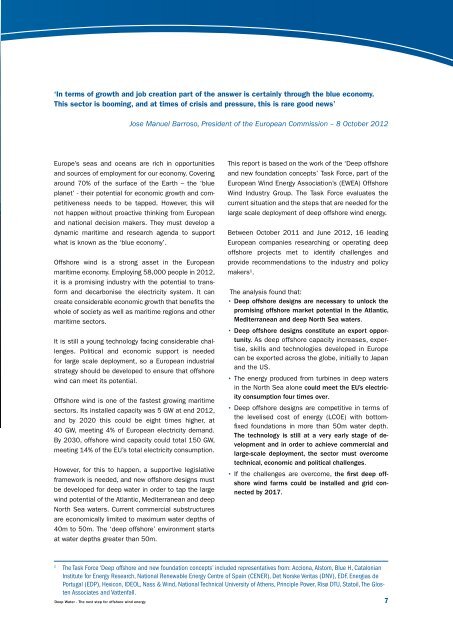Deep_Water
Deep_Water
Deep_Water
Create successful ePaper yourself
Turn your PDF publications into a flip-book with our unique Google optimized e-Paper software.
‘In terms of growth and job creation part of the answer is certainly through the blue economy.<br />
This sector is booming, and at times of crisis and pressure, this is rare good news’<br />
Jose Manuel Barroso, President of the European Commission – 8 October 2012<br />
Europe’s seas and oceans are rich in opportunities<br />
and sources of employment for our economy. Covering<br />
around 70% of the surface of the Earth – the ‘blue<br />
planet’ - their potential for economic growth and competitiveness<br />
needs to be tapped. However, this will<br />
not happen without proactive thinking from European<br />
and national decision makers. They must develop a<br />
dynamic maritime and research agenda to support<br />
what is known as the ‘blue economy’.<br />
Offshore wind is a strong asset in the European<br />
maritime economy. Employing 58,000 people in 2012,<br />
it is a promising industry with the potential to transform<br />
and decarbonise the electricity system. It can<br />
create considerable economic growth that benefits the<br />
whole of society as well as maritime regions and other<br />
maritime sectors.<br />
It is still a young technology facing considerable challenges.<br />
Political and economic support is needed<br />
for large scale deployment, so a European industrial<br />
strategy should be developed to ensure that offshore<br />
wind can meet its potential.<br />
Offshore wind is one of the fastest growing maritime<br />
sectors. Its installed capacity was 5 GW at end 2012,<br />
and by 2020 this could be eight times higher, at<br />
40 GW, meeting 4% of European electricity demand.<br />
By 2030, offshore wind capacity could total 150 GW,<br />
meeting 14% of the EU’s total electricity consumption.<br />
However, for this to happen, a supportive legislative<br />
framework is needed, and new offshore designs must<br />
be developed for deep water in order to tap the large<br />
wind potential of the Atlantic, Mediterranean and deep<br />
North Sea waters. Current commercial substructures<br />
are economically limited to maximum water depths of<br />
40m to 50m. The ‘deep offshore’ environment starts<br />
at water depths greater than 50m.<br />
This report is based on the work of the ‘<strong>Deep</strong> offshore<br />
and new foundation concepts’ Task Force, part of the<br />
European Wind Energy Association’s (EWEA) Offshore<br />
Wind Industry Group. The Task Force evaluates the<br />
current situation and the steps that are needed for the<br />
large scale deployment of deep offshore wind energy.<br />
Between October 2011 and June 2012, 16 leading<br />
European companies researching or operating deep<br />
offshore projects met to identify challenges and<br />
provide recommendations to the industry and policy<br />
makers 1 .<br />
The analysis found that:<br />
• <strong>Deep</strong> offshore designs are necessary to unlock the<br />
promising offshore market potential in the Atlantic,<br />
Mediterranean and deep North Sea waters.<br />
• <strong>Deep</strong> offshore designs constitute an export opportunity.<br />
As deep offshore capacity increases, expertise,<br />
skills and technologies developed in Europe<br />
can be exported across the globe, initially to Japan<br />
and the US.<br />
• The energy produced from turbines in deep waters<br />
in the North Sea alone could meet the EU’s electricity<br />
consumption four times over.<br />
• <strong>Deep</strong> offshore designs are competitive in terms of<br />
the levelised cost of energy (LCOE) with bottomfixed<br />
foundations in more than 5Om water depth.<br />
The technology is still at a very early stage of development<br />
and in order to achieve commercial and<br />
large-scale deployment, the sector must overcome<br />
technical, economic and political challenges.<br />
• If the challenges are overcome, the first deep offshore<br />
wind farms could be installed and grid connected<br />
by 2017.<br />
1<br />
The Task Force ‘<strong>Deep</strong> offshore and new foundation concepts’ included representatives from: Acciona, Alstom, Blue H, Catalonian<br />
Institute for Energy Research, National Renewable Energy Centre of Spain (CENER), Det Norske Veritas (DNV), EDF, Energias de<br />
Portugal (EDP), Hexicon, IDEOL, Nass & Wind, National Technical University of Athens, Principle Power, Risø DTU, Statoil, The Glosten<br />
Associates and Vattenfall.<br />
<strong>Deep</strong> <strong>Water</strong> - The next step for offshore wind energy 7


